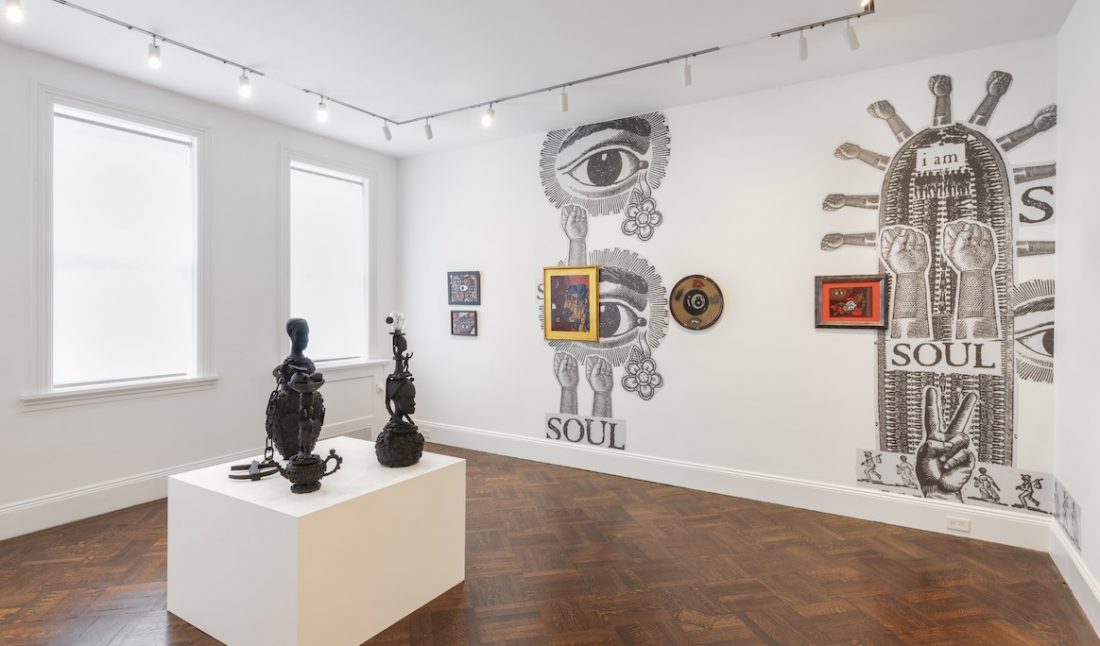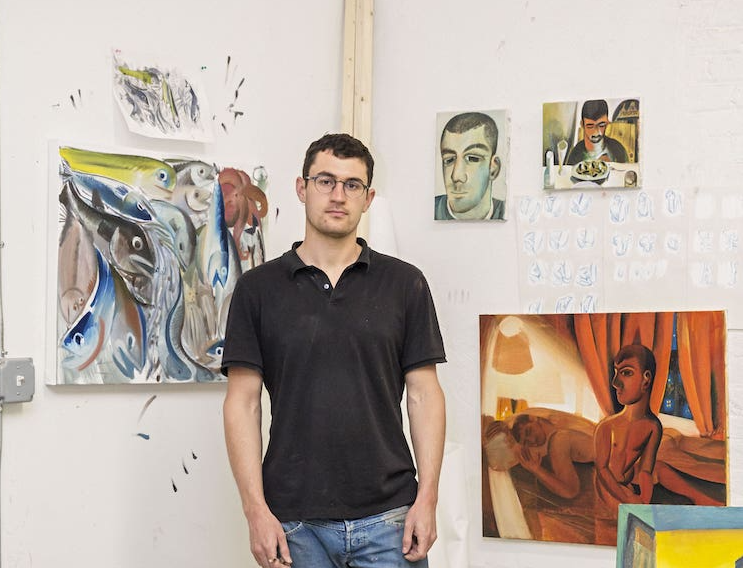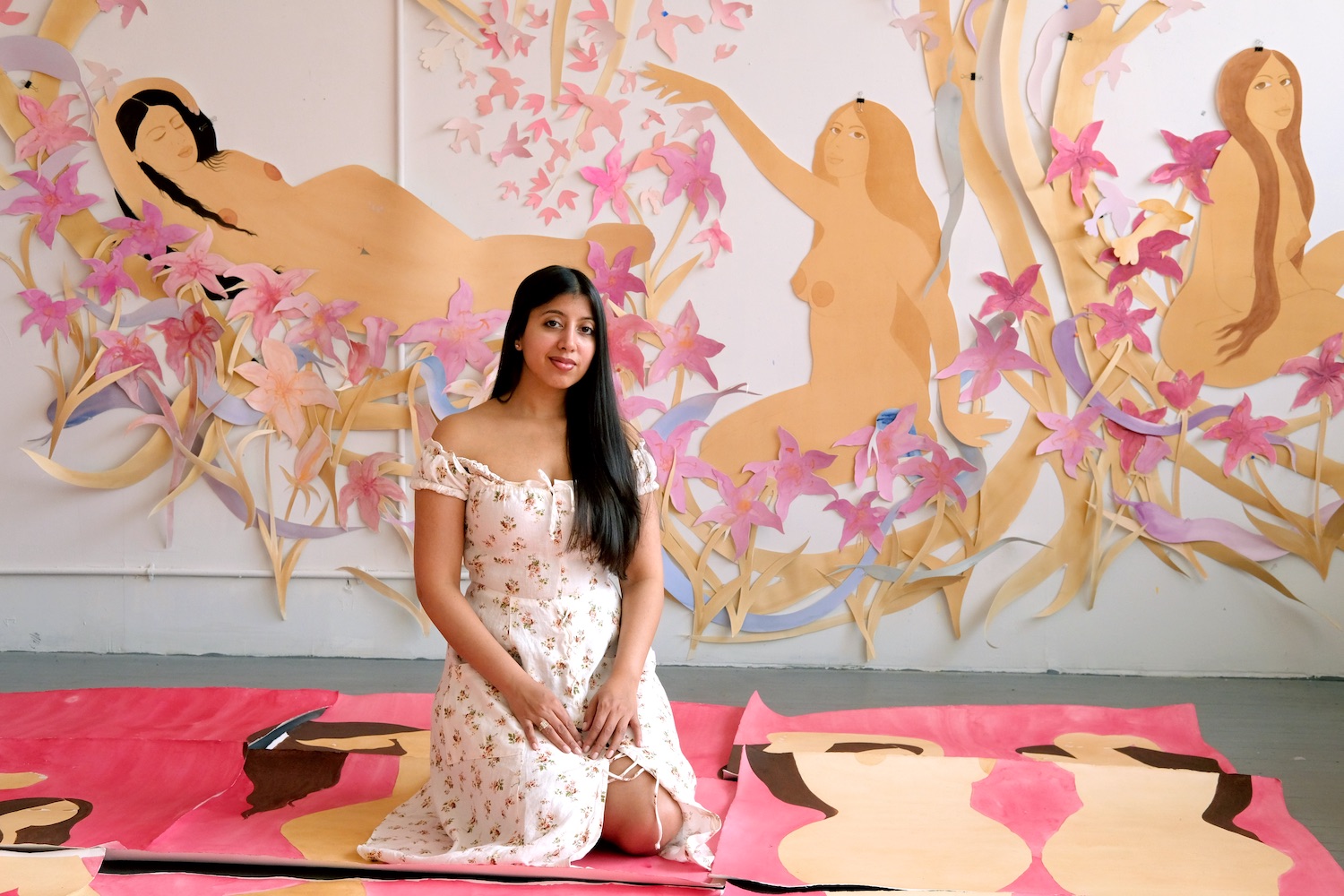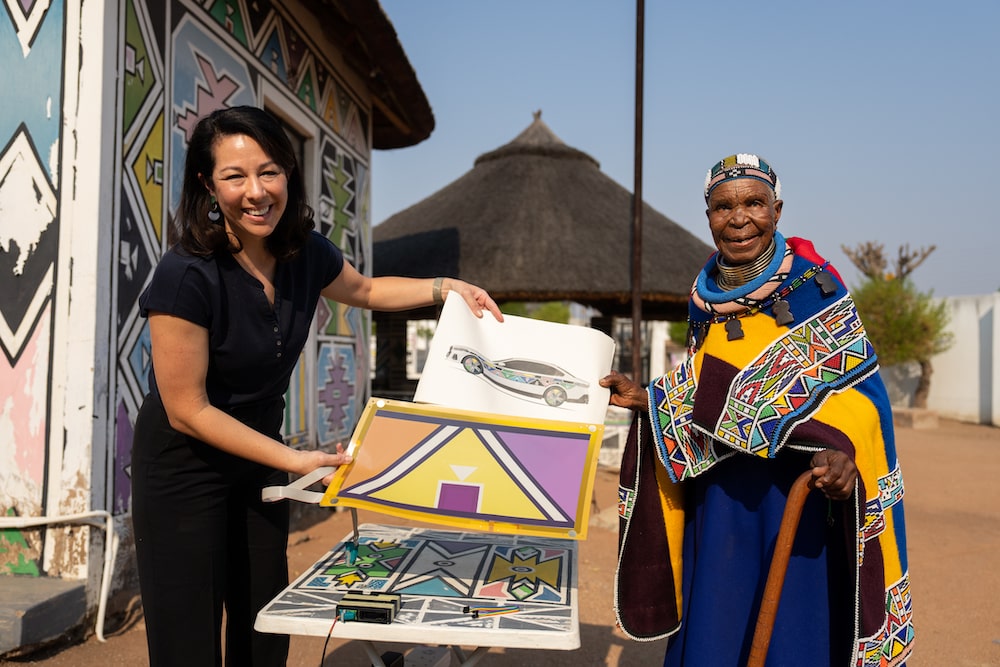“Colored Entrance” by Jan Wade at Richard Saltoun in New York (on view now through June 22) is strewn with fundamental forms, familiar enough to entice yet strange enough to challenge. A medley of crosses adorn the rich orange wall in Epiphany (1994 – 2012), whispering histories (“AND THEY SOLD US LIKE BEASTS”) and prayers (“I AM”). One of Wade’s Memory Jug sculptures rests nearby glittering with buttons and found treasures; elsewhere hangs Breathe (2020-2022), a vibrant wave of embroidered linen echoing a long tradition of quilting and ancient preservation.
Born in Hamilton, Canada in 1952, Wade is celebrated for her explorations of Black identity and postcolonial critiques, working in lineages both ancient and recent. “Colored Entrance” marks Wade’s first solo exhibition in the United States––an overdue welcome, given her exploration of and elaboration upon African American ideologies and practices. Wade sat down with us to discuss presence in creativity, her influences across space and time, and the necessity for unity in a hyper-connected world.
 Jan Wade, “Breathe” installation, 2020-2022, embroidered linen, 32.5 x 140.5 inches; courtesy of the artist and Richard Saltoun, Photo by Adam Reich.
Jan Wade, “Breathe” installation, 2020-2022, embroidered linen, 32.5 x 140.5 inches; courtesy of the artist and Richard Saltoun, Photo by Adam Reich.
WHITEWALL: This is your first solo exhibition in the United States, but a great deal of your work echoes traditions found across North America, found in the practices of artists like the Gees Bend quilt-makers and Thornton Dial. How did you connect with these traditions?
JAN WADE: After I was born, my parents were very young and both worked, and so I spent the days with my great-grandmother and grandmother, both who were from the southern United States. The second time I went to see the ladies of Gees Bend, I just sat there with my eyes closed because it was like I could hear my great-grandmother and grandmother’s voices in their voices. It almost made me want to weep. I ended up talking to them later; I showed them a piece of my embroidery. I said, Well, I don’t quilt, but I have a way of quilting with embroidery. “Oh, Jan, go Jan. Keep on going Jan,” they said. I mean, they were so lovely. They really were. It was like making plans with my grandmother.
WW: That brings us to Breathe (2020-2021), a piece that blurs the aesthetics of embroidery and quilting––how did that work take shape?
JW: When I was younger, I thought for a long time about quilting. For some reason I just didn’t take to it. One day, I found a bag of embroidery thread at the thrift store. I worked with it on and off for years, then I received a Canada Council grant and began working with it again. Around the same time one of the textile stores had a sale on linen. It was probably one of my teachers from art college who told me to never embroider on anything but silk or linen. Open an Egyptian sarcophagus and the mummy will be wrapped in linen; it’s still there, you know? Make sure you’re always doing the work on something that’s worthy of your efforts. I bought about 10 yards of linen and started again. I’m still making Breathe panels today. It’s sort of like you’re a horse in a race––you reach a certain pace and you just can’t stop, you have to keep going.
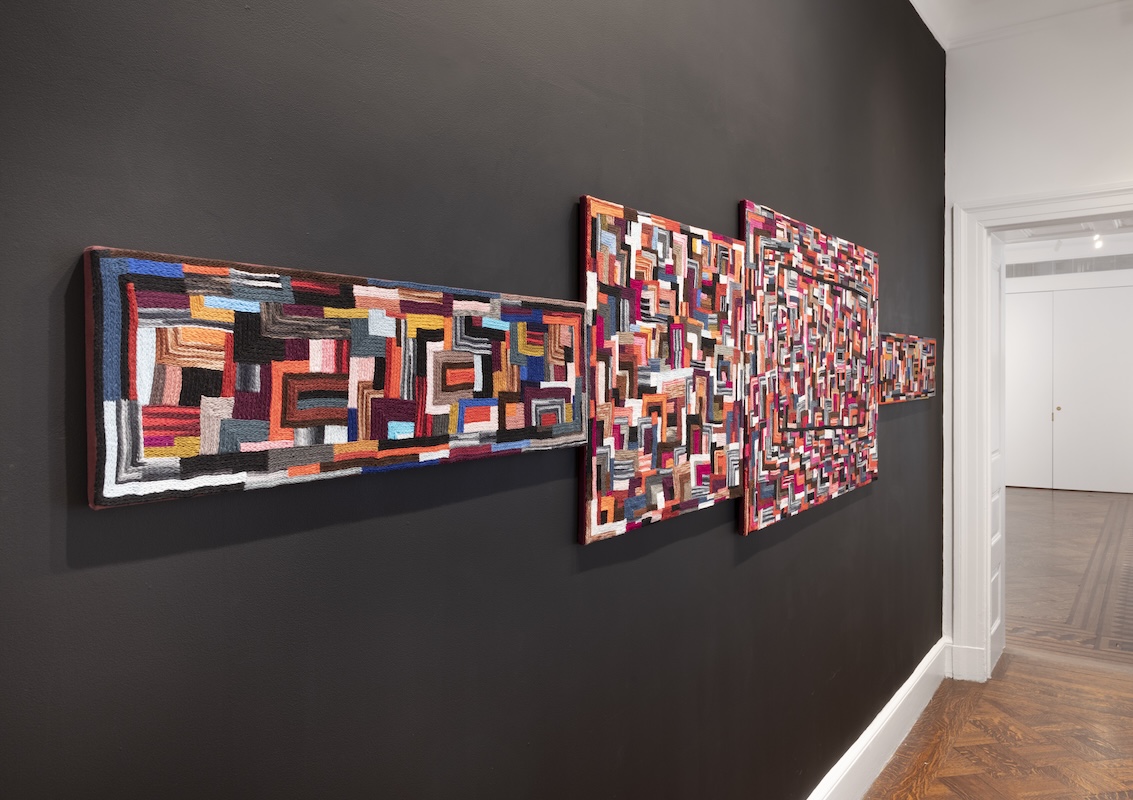 Jan Wade, “Breathe” installation, 2020-2022, embroidered linen, 32.5 x 140.5 inches; courtesy of the artist and Richard Saltoun, Photo by Adam Reich.
Jan Wade, “Breathe” installation, 2020-2022, embroidered linen, 32.5 x 140.5 inches; courtesy of the artist and Richard Saltoun, Photo by Adam Reich.
“Make sure you’re always doing the work on something that’s worthy of your efforts,” — Jan Wade
WW: This study of traditional methods is a constant part of your practice. You’ve spoken in the past about your love of old things and the memory they have. What roles do historic objects play in your work?
JW: Old things have always fascinated me. I remember being really young and going into my grandmother’s bedroom; she had these old things, perfume bottles, this and that. As I was picking up these things, I felt that they were things that I remembered more than I was discovering. They just appealed to me. I love that they already have a mysterious history.
Back in the days of slavery, when people wanted to make some kind of monument for burial, they would just put the deceased’s belongings on the grave: their few pieces of clothing, maybe a favorite plate or a jug or something like that. I also remember seeing these old African American grave sites with big, wooden, almost-modernist pieces there. And of course, those pieces were meant to just dissolve back into the earth. It’s the same in West Africa; there are certain places where people make these kinds of shrines––some are renewed, but some of them are just meant to disintegrate back into the ground.
In thinking about these traditions, I wanted to make something intended for graves. When I started collecting pieces for the Memory Jug series, I had a whole collection of old tourist objects. Of course, they would reflect a history of racism or sexism, or some kind of idealized history of the past––that past. When I started putting them all on my table, the jugs, artifacts, pieces, it was almost like they were building themselves.
WW: On the topic of spiritual objects, I’d love to touch on Epiphany (1995/2018) for a moment. I know it’s earlier work.
JW: Well, it came out of being raised in a Black church, something I had an incredibly positive experience of. Our church was like a family. My family, all my aunts and uncles sang in the choir. My uncle was the choir director of the church for over 50 years. It came from that experience, but it also came about after one of my younger brothers passed away from cancer.
It took me back to a real question about life and death, the spiritual aspect of life. I was walking along the street one night in this funky old neighborhood in Toronto. There was this big pile of really beautiful discarded wood, and I just picked that together and made a cross. And then I just scooped up about six pieces of this wood that I made my first crosses, and the first crosses were painted, because I hadn’t really kind of thought about attaching the more sculptural elements to them yet. When I moved back to Vancouver, I started making crosses of all sizes, gluing things on so that each one was different.
It’s about my own spiritual upbringing and history, and the history of my family. It’s also the question of spiritual practice, because, of course, at a certain point, when I was really young, I bought everything that was tossed at me. As I grew older and learned the history of these ideas, things became more clear. I find it interesting that two of the oldest sects of Judaism and Christianity are in Ethiopia, yet somehow, in recent history, Africans had to be Christianized and in order to be considered human.
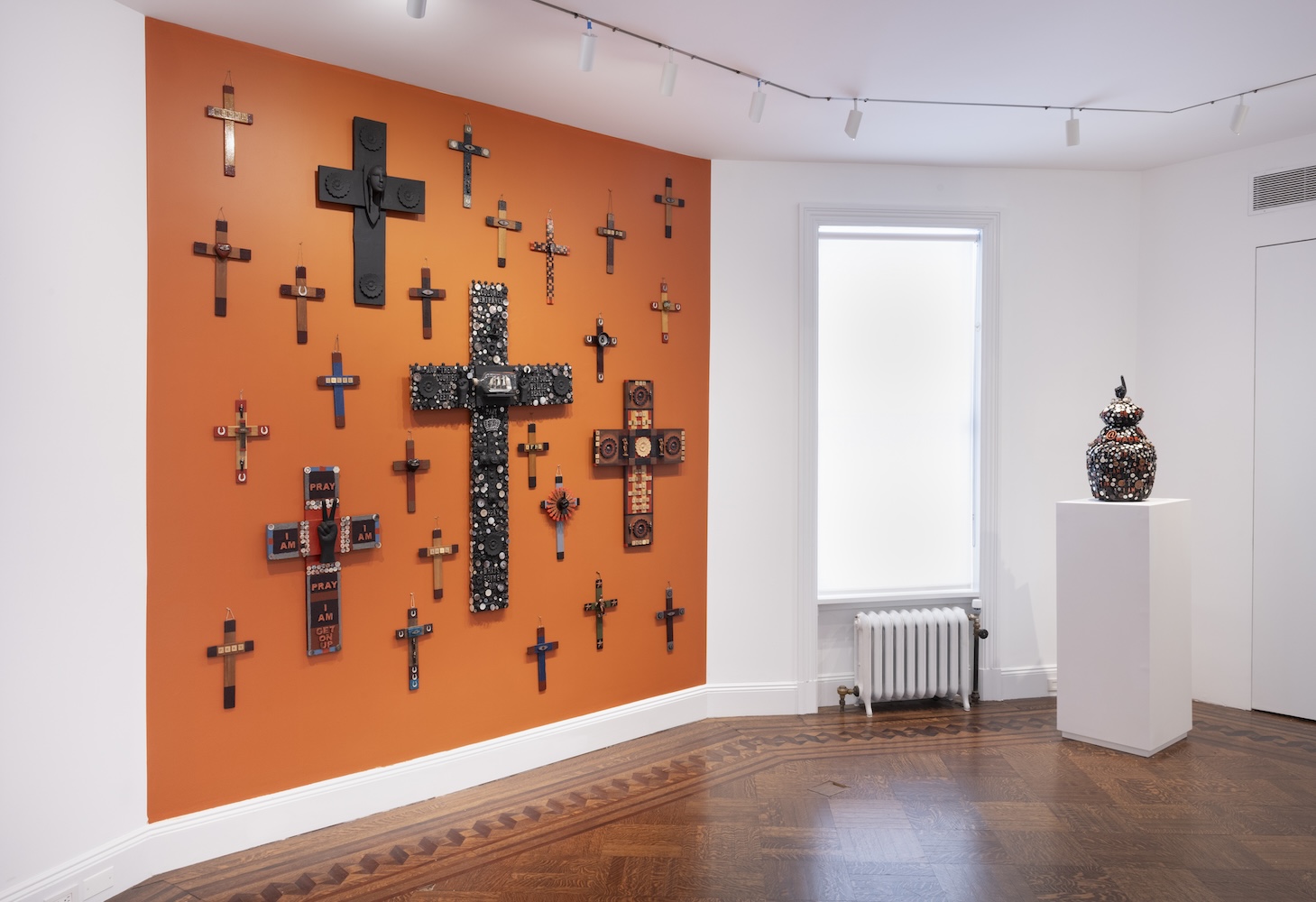 Installation view of Jan Wade’s “Epiphany” in “Colored Entrance,” Courtesy of Richard Saltoun, Photo by Adam Reich.
Installation view of Jan Wade’s “Epiphany” in “Colored Entrance,” Courtesy of Richard Saltoun, Photo by Adam Reich.
“It’s about my own spiritual upbringing and history, and the history of my family.” — Jan Wade
WW: There are consistent themes of memorial throughout “Colored Entrance.” Do you intend for all these works to last?
JW: That’s a good question. Nothing lasts, eventually. I mean, maybe if I become really famous and people decide, “Hey, this has to last, man!”, then people will put energy into preserving them. If not, they won’t.
WW: You seem to be at peace with that. Our culture can be pretty obsessed with preservation––this idea of the eternal. What do you think is important to preserve?
JW: Things of beauty are always worth preserving. When I’m making the Memory Jugs, I’m using artifacts and detritus, all things that have somehow lasted. Someone preserved them along the way for whatever reason, or they preserved themselves. I’m turning them into another form, preserved for a while. It’s a bit up in the air, you know, who gets preserved and who doesn’t. That’s the thing about us Westerners, we think that we’re in control when we aren’t in control of anything. The older I get, the more I realize that I don’t know anything. I keep thinking, I keep reading, I keep looking, I keep learning, but it barely scratches the surface.
WW: Well, I have heard that you’re a voracious reader.
JW: My parents were both voracious readers. On one side of their bedroom was my mom’s bookshelf, and on the other side was my dad’s. My mom had more novels and poetry, and my dad had more history books. I read Bury My Heart at Wounded Knee when I was 14, and then at 15, I read The Rise and Fall of the Third Reich, just because my dad had it. I remember being shocked, saying to him, “God, Dad, those Nazis!”
At that age, you’re starting to realize how complex humanity is even in the terms of your own history. I grew up in a relatively young Black community in Hamilton and went to a Black church. And, you know, you start unpacking all of that stuff, and even the history of your own family and wonder: How did you people survive to even have me? Plus, my parents were one of the first official interracial couples. When they got engaged, my dad got hauled into the Hamilton Police Department by the morality squad. Miscegenation was still against the law until the late 1970s in Canada. People were getting married anyway, but it was still legally banned. That’s not so long ago.
I remember watching the whole Civil Rights Movement on TV. As a matter of fact, I was having this conversation with somebody the other night, because they were going on about how the first war on television was the war in Iraq. No! The first televised war was in Vietnam. And that’s why they stopped televising wars to that extent, because it really turned the tide of how people thought about the Vietnam War. Everybody was seeing the massacre at My Lai on the six o’clock news.
WW: We’re having a moment like that now, but a million times more because there’s no limit to the information.
JW: Yes, with these devices, nothing can be secret anymore. I just got my first iPhone. I’m trying to leave it alone. I’m not one of those people that texts on the bus. I was taking the bus the other day, taking one of my favorite staycations in Vancouver––the 250 bus that goes along this meandering, beautiful route. And people were on their phones the whole time. I think that these devices are incredible in their way. But I think they also take something from us. I suppose too that’s my fascination with all things: How did people do things? How do people see things? Sometimes I think previous generations were really ahead of us in that they weren’t distracted by the same things. They were really looking and making things with their hands.
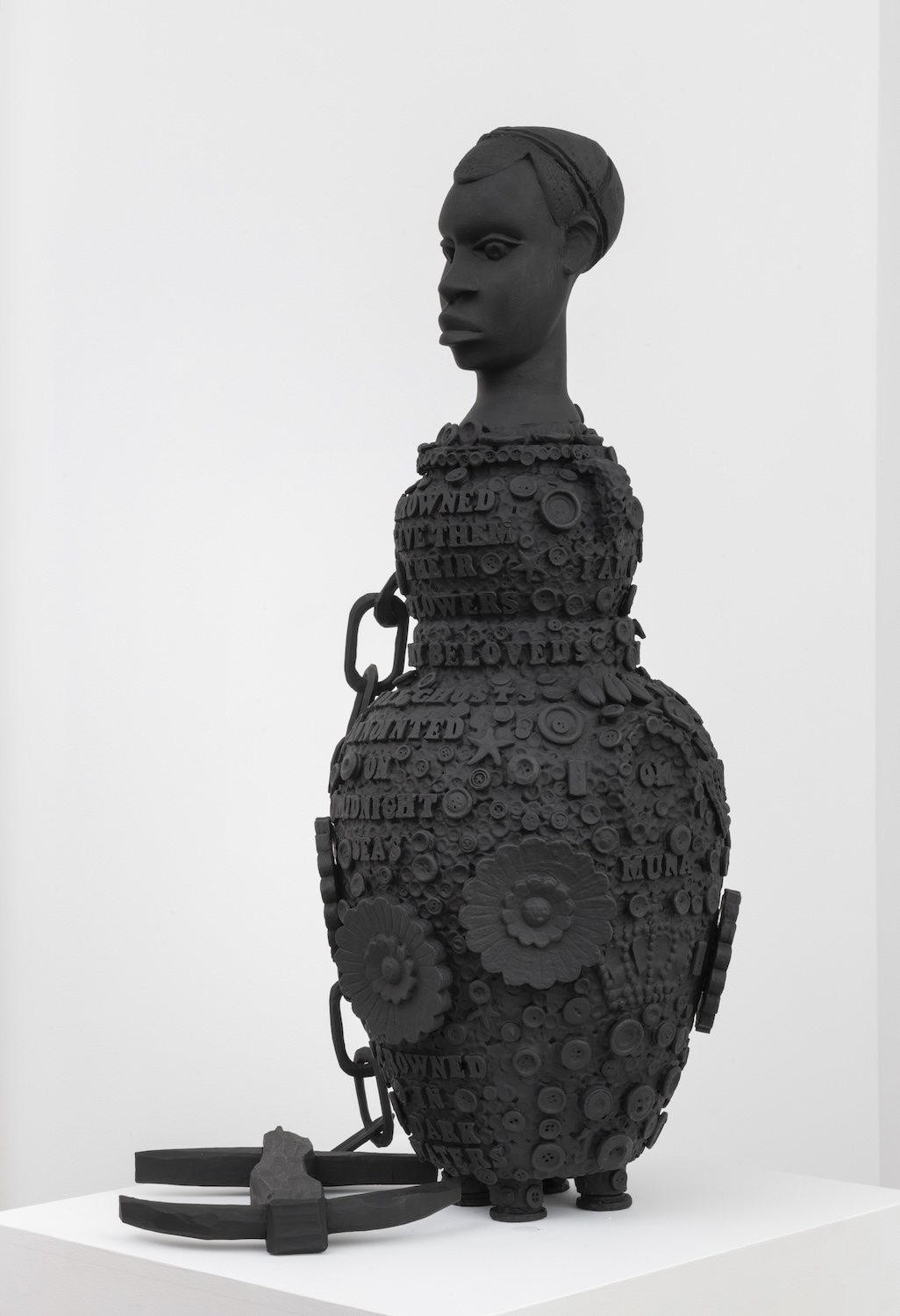 Jan Wade, “Crowned,” 2023/24, acrylic, wood, found objects and clay vessel, 35 x 9 x 12 inches, courtesy of the artist and Richard Saltoun, Photo by Adam Reich.
Jan Wade, “Crowned,” 2023/24, acrylic, wood, found objects and clay vessel, 35 x 9 x 12 inches, courtesy of the artist and Richard Saltoun, Photo by Adam Reich.
“Things of beauty are always worth preserving,” — Jan Wade
WW: Definitely. And while “craft” has found more of a place in institutions recently, it certainly wasn’t always that way.
JW: Even when I started doing the first pieces for Breathe, 30 years ago, I never thought I never thought they’d be up on the wall in the Vancouver Art Gallery. I was just doing it for my own interest.
WW: But that’s a special thing. With all the information we have, artists often feel that everything has to be made for something. And if it isn’t made for something, then they feel it’s worthless and there’s no point.
JW: Yes, you see, whereas I never make anything thinking it’s going to be made for anything. [laughs]
WW: And here we are. That’s a nice reminder. Can you tell me about how you started making art?
JW: I always drew. I was probably drawing before I talked… one of those! I went to a comprehensive arts high school in Hamilton; it was a wonderful time. We had just completely lucked out. In grade nine, you had to come from Hamilton and the surrounding area to the school with your portfolio, and show it to a committee. When I went to do my interview at the Ontario College of Art and Design, the interviewer wanted to buy a drawing from me. So I came out and everybody was looking at me going, did you get in? I said, I don’t know. But the guy that was interviewing me wanted to buy a drawing…
WW: A good sign.
JW: Yes, but still, I was the only Black student in my high school program. And I was the only Black student at the Ontario College of Art and Design, and in those years there wasn’t any Black studies program. I got a job working in the library, which meant I got the sacred back room key where they had the research library, where usually only teachers were allowed. I read every book I could find about Africa, the Horn of Africa, Southern Black art, etc.
WW: Did you have any black teachers or mentors?
JW: I do have one. A long time ago, I did a show up in Banff. I had been in Cuba studying Santería––I was interested in the spiritual practices of the descendants of African slaves. One of the younger curators saw my work and suggested I look at the work of Betye Saar. I went to the library there, picked up her book, and it was like a light shining down, shouting: “you’re not alone!”
I went to Johannesburg to participate in the biennale in 1995––Nelson Mandela had only been president for seven and a half months. Somebody told me that Saar’s work was there. I sat in the installation for about an hour, so happy I was seeing her work in real life. I went back to the elevator and I heard this little American voice––“hold the elevator!” A little woman rushed in there with a mauve afro, and I asked, “Are you with the Americans? Do you know the artist Betye Saar?” And she said, “Well, I am Betye Saar.” We’ve known each other since then. I actually just mailed Betye a letter before coming here.
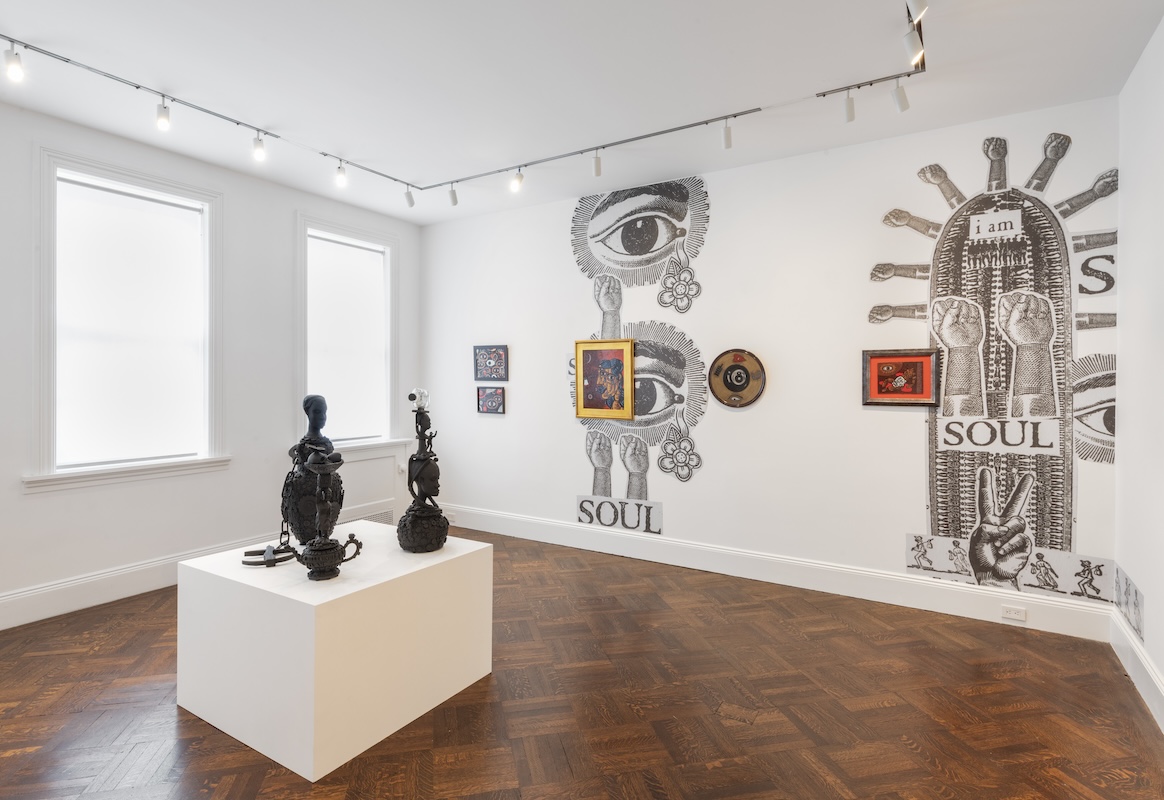 Installation view of Jan Wade’s “Colored Entrance,” courtesy of Richard Saltoun, Photo by Adam Reich.
Installation view of Jan Wade’s “Colored Entrance,” courtesy of Richard Saltoun, Photo by Adam Reich.
“When I went to do my interview at the Ontario College of Art and Design, the interviewer wanted to buy a drawing from me,” — Jan Wade
WW: Are there any other artists who you’re thinking about these days?
JW: I’ve been intrigued by Ai Weiwei’s fascination with buttons. I share that fascination… I actually have a button collection. They are these little things, totally taken for granted, though they completely elevated the act of holding something together. And then looking at older buttons, how incredibly decorative and inventive they were. I use them in my work a lot; when you see patterns in some of my memory jug pieces, it’s just hundreds and hundreds of buttons, sometimes painted over.
WW: Any thing uniting two things is interesting, especially when it feels like there’s a lot of conflict in the world.
JW: And there always has been.
WW: I agree. I think we just have more information; we’re connected with people who have such different experiences and so of course, there will be more contrast… How do you make sense of that?
JW: Well, that is true, but on the other hand, we have an opportunity to see how similar we are. No matter how different our cultures or experiences are, we still have undeniable similarities. I think we have to focus more on the things that make us similar and the things we collectively need, despite the fact that we’re different.
WW: What a perfect note to end on. Thank you so much for speaking with me, Jan.






